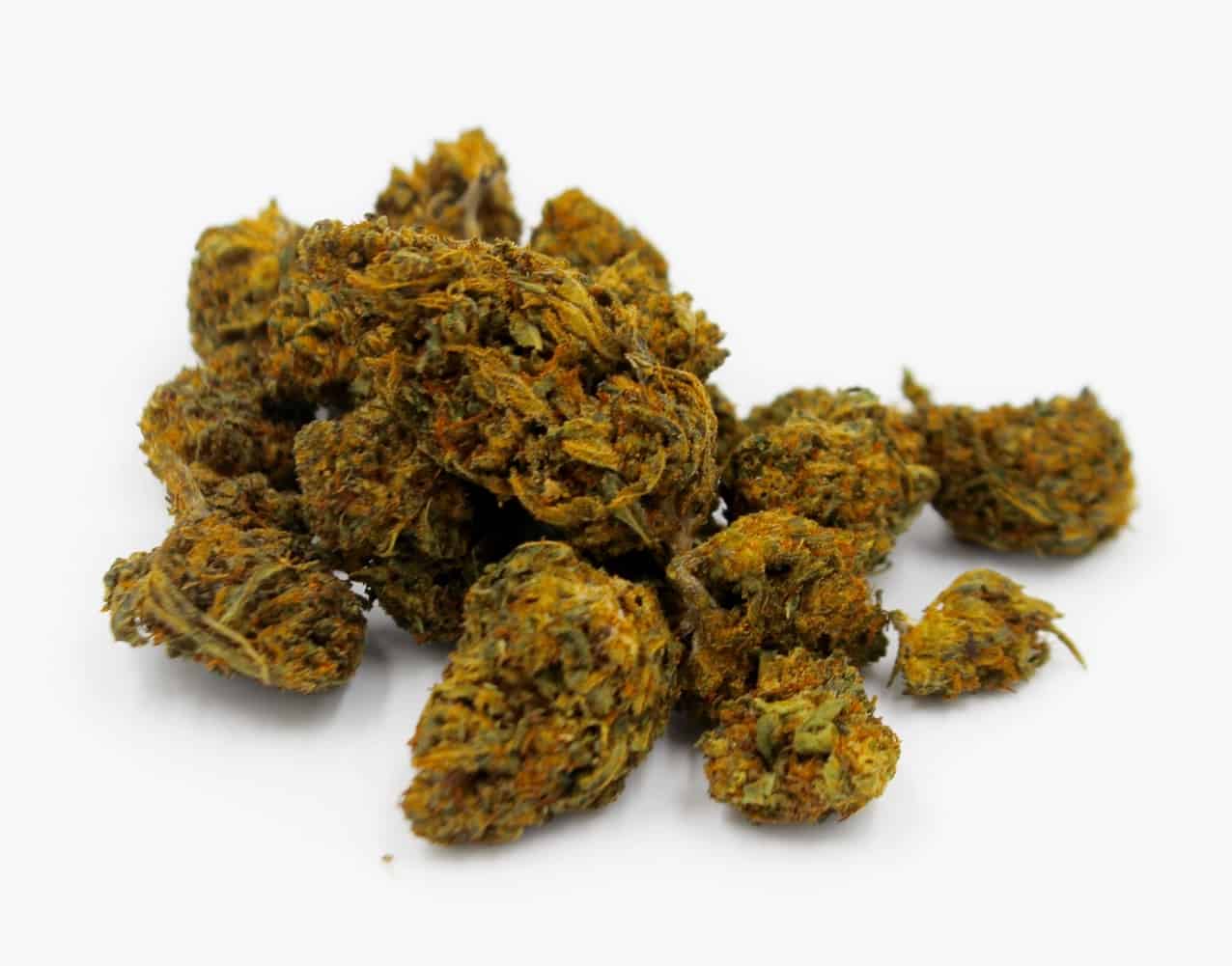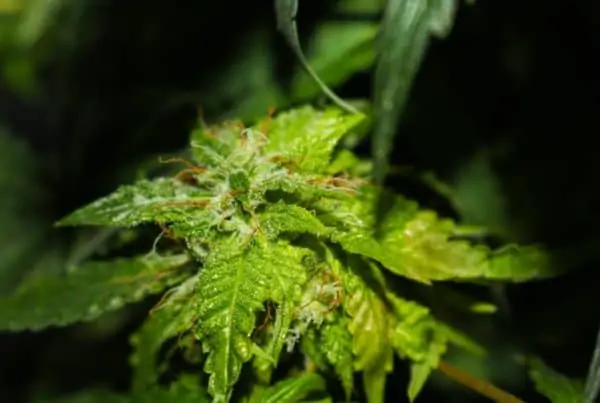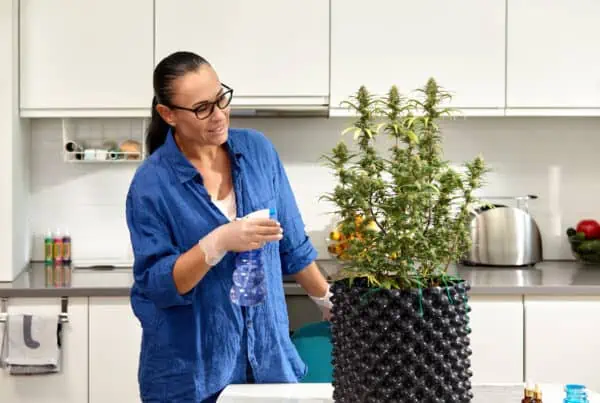TABLE OF CONTENTS
We've all been there. You take a closer look at the weed you just bought or got from a friend, only to realize that it looks and smells a lot different than the high-quality weed you are used to.
If it has more seeds and stems than usual, smells like old hay, and has a dull color, you may be staring at what seasoned users refer to as “dirt weed.”
While low-quality weed can seem like a waste, there are still ways to salvage your stash without having to throw it away completely. Our dirt weed guide covers exactly what dirt weed is, how you can identify it, and what you can do with it to have a great experience.
What Is Dirt Weed?
Dirt weed usually refers to low-quality Mexican weed that became available in the 1970s and was commonly sold for about $10 an ounce. This weed is known for its low potency, poor drying and curing practices, and, sometimes, moldy growth,
Common names for low-quality weed include:
- Schwag
- Regs
- Reggie
- Ditch weed
- Brick weed
Signs of low-quality weed include:
- A lot of stems
- A lot of seeds
- Old hay or ammonia smell
- Brown or yellow color
- No trichomes
- Too dry or moist
- Mold
- Small and airy buds
Dirt weed is usually transported in bricks mixed with several other strains. The weed is compressed which can destroy the trichomes. It may be wrapped up in saran wrap or duct/electric tape.
It is often grown for quantity, not quality, without an effort to remove the male plants, which can frequently produce hermaphrodite plants with tons of seeds. It may also be produced in poor-quality soil without fertilizer.
Dirt weed may be harvested before the trichomes are at their peak maturity. It is usually sundried in piles producing a dry and crumbly texture. Growers do not remove the seeds or stems or trim the bud leaves when harvesting the bud.
Here is how you can tell good weed vs. bad weed apart.
Appearance
You may notice yellow leaves, brown and leafy weed, and minimal or no trichomes. Use a microscope or loupe to get a closer look. Dirt weed may look dry, airy, brown or dark green, and come in very small and broken up buds with curly leaves. It can also come with lots of stems and seeds.
Aroma and Flavor
Most people notice an aroma of old, dry hay and, sometimes, ammonia. If your weed smells like this, it could mean that the bud is old, moldy, or low quality.
While it may have a slight recognizable aroma of weed, it will mostly smell unpleasant or even moldy and must. In terms of taste, it can be harsh, earthy, and not as complex-tasting as high-quality strains.
Consistency
If you can't tell by looks or smell alone, you can use your other senses to determine its quality. Even if it's very dry, that doesn't necessarily mean it is low quality. In some low humidity and high-elevation environments, cannabis can be naturally dryer making buds crumbly even with the tiniest bit of pressure.
In other areas, there may be more moisture which makes the harvested buds harder to break and grind. Overall, the nugs should not feel too moist. If they do feel too moist, you should break them open and check for bud rot.
High-quality weed should also feel sticky due to the trichomes. Dirt weed may have a smaller amount of trichomes that are not as ripe as resin in high-quality weed. Still, dirt weed may still feel sticky to the touch. If it feels mildly sticky, you may have dirt weed on your hands.
Can Dirt Weed Get You High?
Generally, dirt weed has low to moderate THC levels ranging from 10 to 15%, although some strains can have THC levels up to 20%. For some users with lower tolerances, dirt weed can be all they need.
For those who are used to higher potency strains, dirt weed can produce minimal to no effects. Overall, it can produce mild intoxication good for a manageable, daytime high.
Is Dirt Weed Safe to Consume?
Unfortunately, there is no easy way to answer this. It all depends on the type of dirt weed that you have. Some dirt weed may be fine to consume. It may just produce a harsher hit with little to no smell, headaches, and weak effects.
It is when the bad weed contains harmful additives and unflushed synthetic fertilizer and nutrients that it can be harmful to your health if consumed in high amounts and frequently.
What Can You Do With Dirt Weed?
Just because your weed may not look, smell, or taste as good as other strains, it doesn't mean it is completely worthless. If it's not moldy and doesn't have any bugs or pests or clear signs of toxic chemicals, you can definitely use it to make a variety of cannabis consumables.
Grow Weed
One of the defining characteristics of dirt weed is the high number of seeds you may find hidden within the buds. While it may be annoying to pull them out when packing a bowl or joint, you can keep these dirt weed seeds and experiment by growing them.
Many users have used good growing practices and have grown big and tall plants indoors and outdoors using dirt weed seeds. However, you may have to wait a little longer for its flowering compared to high-quality feminized cannabis seeds. It can take several months to flower but can be completely worth it.
Make Concentrates and Infusions
There are many ways to create a concentrated resin and refine it to make a variety of derivative products such as edibles, topicals, concentrates, and suppositories. Through a variety of extraction methods and infusions, you can extract the cannabinoids and terpenes from the low-quality bud and leave behind the harsh plant matter.
Mix With High-Quality Weed
If you have some dirt weed on you, you can use it to supplement your bowls, joints, or blunts. Just get a bit of dirt weed and mix in some higher-quality weed to offset the earthy smell of dirt weed. You may even store both qualities of weed together to kind of balance out the moisture levels.
What is Ditch Weed?
Ditch weed, also known as feral cannabis, or wild marijuana, refers to a group of wild-growing cannabis plants that originated from industrial hemp plants previously cultivated for fiber.
One distinguishing characteristic of ditch weed is its low or negligible tetrahydrocannabinol (THC) content. You'll usually find them growing in the ditch, off the roadside, or places, where they weren't planted or tended by choice.
Some people smoke ditch weed, but the effect you get from it is not comparable to that obtainable from a well-grown marijuana strain.
Nonetheless, according to reports from a handful of consumers, ditch weed still produces a classic cannabis high if dried and appropriately cured. However, this isn't generally the case.
One exciting thing about ditch weed is that they grow in numbers, i.e., you'll typically find many of them growing on their own. Perhaps the lack of human care and tending is why they are deficient in THC.
Early in the 20th century, farmers and many locals observed (in line with the report of the U.S. Division of Agriculture) cannabis growing in the wild and abundance in many Midwestern territories, including western Iowa, Missouri, and southern Minnesota.
To date, ditch weed continues to grow, even in Nebraska, Indiana, and Kansas. If you take a road trip across Kansas, Iowa, Minnesota, and Nebraska, you'll notice them growing in large fields, distinguished by their tall green leaves and pungent odor.
It would interest you to know that the United States Drug Enforcement Administration believes that 90-98% of weed consumed by lots of folks in the US is a feral weed.
Is Ditch Weed Legal?
Generally speaking, the legal status of cannabis in the United States can be a tad confusing in the sense that the laws governing the growing, sale, and use of cannabis differ from state to state. Ditch weed, despite being very low in THC, is not exempt from regulations.
Expectedly, whether the level of THC is high or low, if in the wrong hands and used inappropriately, significant damage may arise.
However, ditch weed is legal as it descended from industrial hemp and has very low THC. The Farm Bill stipulates that it is legal to grow industrial hemp anywhere in the United States. There are still places in the United States, such as Nebraska, Iowa, Idaho, and Kansas, where the use of cannabis is prohibited.
Eradicating Ditch Weed
A considerable amount of effort exercised by the DEA is actually channeled towards eradicating ditch weed from America. In 1979, the DEA created the Domestic Cannabis Eradication/Suppression program. The program uses federal funds to eradicate the growth and spread of ditch weed.
Within 13 years, the program eradicated over 118 million feral weed plants, whereas only 6 million cannabis plants were deliberately cultivated within the same period.
According to a report published online in the Sourcebook of Criminal Justice Statistics, approximately 99% of all marijuana eradicated by the DEA in the Domestic Cannabis Eradication/Suppression Program in 2003 was a ditch or feral hemp and was not cultivated.
This is not only worrisome, but it also calls for more work to be done in getting rid of ditch plants.
The proliferation of ditch weed seems out of control in some places, so much so that authorities have given up the fight altogether.
In Indiana, for instance, the government has totally abandoned weed eradication because of the continued sporadic spread of the plant and, of course, the funds expended in trying to check the growth of unwanted cannabis plants.
Surprisingly, some people engage in nefarious acts that undermine the efforts of the authorities in this regard. It's common practice to maneuver the law by planting and cultivating marijuana seeds in the ditch and then returning later to harvest the plant.
The DEA believes that marijuana found growing in the ditch occurred naturally and was not cultivated. The police are actually on the lookout for persons engaged in this practice, especially in states where marijuana is not allowed for any use whatsoever.
How To Identify Wild Weed
Wild weed can grow as tall as 8-9 feet. Because it is not tended like indoor-grown or properly farmed weed, it's leaves are often not as sticky. Also, as already mentioned, you'll mostly notice them in ditches and waysides. But most significantly, you can identify the wild or feral weed by their negligible psychoactive effect. This means that they have deficient levels of THC in them.
Can You Smoke Ditch Weed?
People smoke ditch weed, but the experience does not compare with smoking a good roll of joint made from a well-grown cannabis bud. Smoking it will hardly get you high. Therefore, if you want the juice or primary substance in marijuana, ditch weed would be the last option you want to turn to.
Dirt Weed FAQ's
Why is it called dirt weed?
The name “dirt weed” stems from its low quality, which resembles dirt. It looks and smells like dirt, unlike higher-grade cannabis.
“
There are over 300,000 jobs in the cannabis industry. CTU trained me for one of them!

Makes $24.50 @ THC +
Is dirt weed safe to consume?
Consumer safety of mud weed depends on its state. Dirt cannabis may be safe but harsher to smoke and have poor effects. If it has mold, vermin, or dangerous substances, it may be unhealthy. Check it carefully before eating.
How do you identify dirt weed?
Appearance, smell, and feel distinguish soil weed. A dry or crumbly texture, yellow leaves, brown and leafy texture, little trichomes, and an old hay or ammonia scent are possible. It may also feel dry or damp, and if its excessively moist, check for bud redness
What can you do with dirt weed?
Dirt weed can be used to manufacture edibles, topicals, and concentrates if it's still fresh. Also, earth weed seeds can be grown. Smoking dirt cannabis with better strains improves the experience.
Are there any benefits to using dirt weed?
The quality of dirt weed isn't ideal, but it can be handy for budget-conscious or mild-high users. Amateur cannabis growers can save money using its seeds.
How does dirt weed compare to mid-grade or top-shelf weed?
Mid-grade or top-shelf weed is far better than dirt weed. It has fewer trichomes, less THC, and lesser flavor and scent. Top-notch cannabis has greater THC, richer tastes, and stronger effects.
Learn to Make A Variety of Cannabis Products at CTU
Do you have dirt weed in your stash? Do you want to transform your dirt weed into a variety of cannabis products?
Enroll in Cannabis Training University’s, the leading cannabis university to learn how to make high-quality edibles, topicals, suppositories, concentrates, and so much more.

Luis Cordova
Luis Cordova is a distinguished author, and renowned expert in cannabis cultivation, who possesses a Master's degree in Plant Biotechnology and Pharmaceutical Science. As a valued contributor to highly esteemed publications such as Cannabis Training University and Maximum Yield Magazine, Luis has emerged as a trusted source of guidance and knowledge in the cannabis industry. Having written thousands of informative articles, Luis is widely recognized for his comprehensive expertise on cultivating cannabis, both indoors and outdoors.












 Jeff was involved in an accident where he endured a traumatic brain injury. He had a week-long stay in ICU where brain surgeons
Jeff was involved in an accident where he endured a traumatic brain injury. He had a week-long stay in ICU where brain surgeons  100% risk free money back guarantee within 48 hours after purchase if student has not completed any of the courses or exams.
100% risk free money back guarantee within 48 hours after purchase if student has not completed any of the courses or exams.